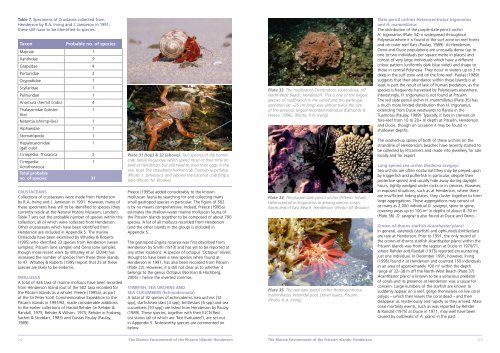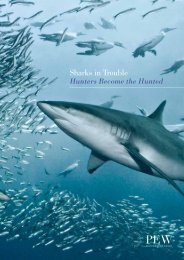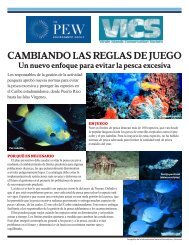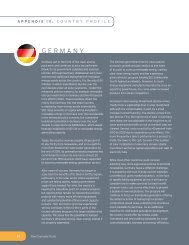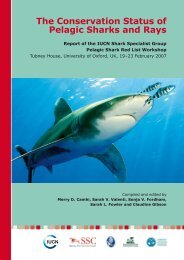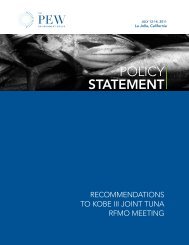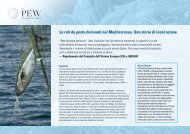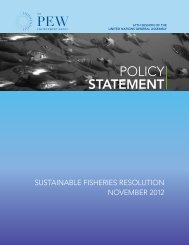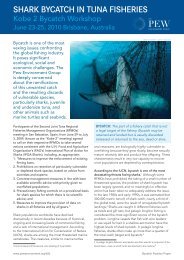The Marine Environment of the Pitcairn Islands - Pew Environment ...
The Marine Environment of the Pitcairn Islands - Pew Environment ...
The Marine Environment of the Pitcairn Islands - Pew Environment ...
You also want an ePaper? Increase the reach of your titles
YUMPU automatically turns print PDFs into web optimized ePapers that Google loves.
Table 7. Specimens <strong>of</strong> Crustacea collected from<br />
Henderson by R.A. Irving and J. Jamieson in 1991;<br />
<strong>the</strong>se still have to be identified to species.<br />
Taxon Probable no. <strong>of</strong> species<br />
Majinae 1<br />
Xanthidae 9<br />
Grapsidae 4<br />
Portunidae 2<br />
Ocypodidae 1<br />
Scyllaridae 1<br />
Palinuridae 1<br />
Anomura (hermit crabs) 4<br />
Thalassinidae (lobsterlike)<br />
1<br />
Natantia (shrimp-like) 1<br />
Alphaeidae 1<br />
Stomatopoda 1<br />
Hapalocarcinidae<br />
(gall crab)<br />
1<br />
Cirrepedia: Thoracica 2<br />
Cirrepedia:<br />
1<br />
Acrothoracica<br />
Total probable<br />
no. <strong>of</strong> species: 31<br />
CRUSTACEANS<br />
Collections <strong>of</strong> crustaceans were made from Henderson<br />
by R.A. Irving and J. Jamieson in 1991. However, many <strong>of</strong><br />
<strong>the</strong>se specimens have still to be identified to species (<strong>the</strong>y<br />
currently reside at <strong>the</strong> Natural History Museum, London).<br />
Table 7 sets out <strong>the</strong> probable number <strong>of</strong> species within this<br />
collection, all <strong>of</strong> which were collected from Henderson.<br />
O<strong>the</strong>r crustaceans which have been identified from<br />
Henderson are included in Appendix 5. <strong>The</strong> marine<br />
Ostracoda have been examined by Whatley & Roberts<br />
(1995) who identified 33 species from Henderson (seven<br />
samples), <strong>Pitcairn</strong> (one sample) and Oeno (one sample),<br />
though more recent work by Whatley et al. (2004) has<br />
increased <strong>the</strong> number <strong>of</strong> species from <strong>the</strong>se three islands<br />
to 47. Whatley & Roberts (1995) report that 25 <strong>of</strong> <strong>the</strong>se<br />
species are likely to be endemic.<br />
MOLLUSCA<br />
A total <strong>of</strong> 326 taxa <strong>of</strong> marine molluscs have been recorded<br />
from Henderson Island (out <strong>of</strong> <strong>the</strong> 502 taxa recorded for<br />
<strong>the</strong> <strong>Pitcairn</strong> <strong>Islands</strong> as a whole). Preece (1995a), as part<br />
<strong>of</strong> <strong>the</strong> Sir Peter Scott Commemorative Expedition to <strong>the</strong><br />
<strong>Pitcairn</strong> <strong>Islands</strong> in 1991/92, made considerable additions<br />
to <strong>the</strong> earlier collections <strong>of</strong> Harald Rehder (in Rehder &<br />
Randall, 1975; Rehder & Wilson, 1975; Rehder in Fosberg,<br />
Sachet & Stoddart, 1983) and Gustav Paulay (Paulay,<br />
1989).<br />
Plate 31 (top) & 32 (above). Two species <strong>of</strong> <strong>the</strong> hermit<br />
crab family Paguridae which spend most <strong>of</strong> <strong>the</strong>ir time on<br />
land at Henderson but still need to shed <strong>the</strong>ir eggs in <strong>the</strong><br />
sea. (top) <strong>The</strong> strawberry hermit crab Coenobita perlatus<br />
(Photo: J. Jamieson); and (above) <strong>the</strong> coconut crab Birgus<br />
latro (Photo: M. Brooke).<br />
Preece (1995a) added considerably to <strong>the</strong> known<br />
molluscan fauna by searching for and collecting many<br />
small gastropod species in particular. <strong>The</strong> figure <strong>of</strong> 502<br />
is by no means comprehensive. Indeed, Preece (1995a)<br />
estimates <strong>the</strong> shallow-water marine molluscan fauna <strong>of</strong><br />
<strong>the</strong> <strong>Pitcairn</strong> <strong>Islands</strong> toge<strong>the</strong>r to be composed <strong>of</strong> about 700<br />
species. A list <strong>of</strong> all molluscs recorded from Henderson<br />
(and <strong>the</strong> o<strong>the</strong>r islands in <strong>the</strong> group) is included in<br />
Appendix 5.<br />
<strong>The</strong> gastropod Engina rosacea was first described from<br />
Henderson by Smith (1913) and has yet to be reported at<br />
any o<strong>the</strong>r locations. A species <strong>of</strong> octopus ‘Octopus’ oliveri,<br />
thought to have been a new species when found at<br />
Henderson in 1991, has also been recorded from <strong>Pitcairn</strong><br />
(Plate 22). However, it is still not clear as to whe<strong>the</strong>r it<br />
belongs to <strong>the</strong> genus Octopus (Norman & Hochberg,<br />
2005) – hence <strong>the</strong> inverted commas.<br />
STARFISH, SEA URCHINS AND<br />
SEA CUCUMBERS (Echinodermata)<br />
A total <strong>of</strong> 32 species <strong>of</strong> echinoderms (sea urchins [12<br />
spp], starfish/sea stars [4 spp], brittlestars [6 spp] and sea<br />
cucumbers [10 spp]) are listed from Henderson by Paulay<br />
(1989). <strong>The</strong>se species, toge<strong>the</strong>r with <strong>the</strong>ir IUCN Red<br />
List status (all <strong>of</strong> which are ‘Not Evaluated’), are set out<br />
in Appendix 5. Noteworthy species are commented on<br />
below.<br />
Plate 33. <strong>The</strong> nudibranch Dendrodoris tuberculosa, <strong>of</strong>f<br />
North-West Beach, Henderson. This is one <strong>of</strong> <strong>the</strong> largest<br />
species <strong>of</strong> nudibranch in <strong>the</strong> world and this particular<br />
specimen (at ~25 cm long) was almost twice <strong>the</strong> size<br />
<strong>of</strong> <strong>the</strong> previous largest recorded individual (Edmunds &<br />
Preece, 1996). (Photo: R.A. Irving)<br />
Plate 34. <strong>The</strong> purple slate pencil urchin (Pitkern: fetuei)<br />
Heterocentrotus trigonarius in among various corals.<br />
North end <strong>of</strong> East Beach, Henderson. (Photo: M. Brooke)<br />
Plate 35. <strong>The</strong> red slate pencil urchin Heterocentrotus<br />
mammillatus. Intertidal pool, Down Isaacs, <strong>Pitcairn</strong>.<br />
(Photo: R.A. Irving)<br />
24 <strong>The</strong> <strong>Marine</strong> <strong>Environment</strong> <strong>of</strong> <strong>the</strong> <strong>Pitcairn</strong> <strong>Islands</strong>: Henderson<br />
<strong>The</strong> <strong>Marine</strong> <strong>Environment</strong> <strong>of</strong> <strong>the</strong> <strong>Pitcairn</strong> <strong>Islands</strong>: Henderson<br />
Slate pencil urchins Heterocentrotus trigonarius<br />
and H. mammillatus<br />
<strong>The</strong> distribution <strong>of</strong> <strong>the</strong> purple slate pencil urchin<br />
H. trigonarius (Plate 34) is widespread throughout<br />
Polynesia where it is found in <strong>the</strong> surf zone on reef fronts<br />
and on outer reef flats (Paulay, 1989). At Henderson,<br />
Oeno and Ducie populations are unusually dense (up to<br />
one to two individuals per square metre in places) and<br />
consist <strong>of</strong> very large individuals which have a different<br />
colour pattern (uniformly dark blue violet) and shape to<br />
those in central Polynesia. <strong>The</strong>y occur in waters up to 3 m<br />
deep in <strong>the</strong> surf zone and on <strong>the</strong> fore-reef. Paulay (1989)<br />
suggests that <strong>the</strong>ir abundance within <strong>the</strong>se <strong>Islands</strong> is at<br />
least in part <strong>the</strong> result <strong>of</strong> lack <strong>of</strong> human predation, as <strong>the</strong><br />
species is frequently harvested by Polynesians elsewhere.<br />
Interestingly, H. trigonarius is not found at <strong>Pitcairn</strong>.<br />
<strong>The</strong> red slate pencil urchin H. mammillatus (Plate 35) has<br />
a much more limited distribution than H. trigonarius,<br />
extending from Ducie westwards to Raroia in <strong>the</strong><br />
Tuamotus (Paulay, 1989). Typically, it lives in crevices on<br />
fore-reef from 10 to 20+ m depth at <strong>Pitcairn</strong>, Henderson<br />
and Ducie, though on occasion it may be found in<br />
shallower depths.<br />
<strong>The</strong> washed-up spines <strong>of</strong> both <strong>of</strong> <strong>the</strong>se urchins on <strong>the</strong><br />
strandline <strong>of</strong> Henderson’s beaches have recently started to<br />
be collected by <strong>Pitcairn</strong>ers and made into jewellery for sale<br />
locally and for export.<br />
Long-spined sea urchin Diadema savignyi<br />
Sea urchins are <strong>of</strong>ten nocturnal (<strong>the</strong>y may be preyed upon<br />
by triggerfish and pufferfish in particular, despite <strong>the</strong>ir<br />
protective spines) and usually hide away during daylight<br />
hours, tightly wedged under rocks or in crevices. However,<br />
in exposed situations, such as at Henderson, where <strong>the</strong>re<br />
are insufficient hiding places, <strong>the</strong>y cluster toge<strong>the</strong>r to form<br />
large aggregations. <strong>The</strong>se aggregations may consist <strong>of</strong><br />
as many as 2,000 individual D. savignyi, spine to spine,<br />
covering areas up to 100 m 2 in depths <strong>of</strong> about 8–30 m<br />
(Plate 36). D. savignyi is also found at Ducie and Oeno.<br />
Crown-<strong>of</strong>-thorns starfish Acanthaster planci<br />
In general, asteroids (starfish) and ophiuroids (brittlestars)<br />
are rare at Henderson. Prior to 1991, <strong>the</strong> only record <strong>of</strong><br />
<strong>the</strong> crown-<strong>of</strong>-thorns starfish Acanthaster planci within <strong>the</strong><br />
<strong>Pitcairn</strong> <strong>Islands</strong> was from <strong>the</strong> lagoon at Ducie in 1970/71,<br />
where Rehder and Randall (1975) reported encountering<br />
just one individual. In December 1991, however, Irving<br />
(1995) found it at Henderson and counted 150 individuals<br />
in an area <strong>of</strong> approximately 100 m 2 within <strong>the</strong> depth<br />
range <strong>of</strong> 32–38 m <strong>of</strong>f <strong>the</strong> North-West Beach (Plate 37).<br />
Acanthaster planci is known to be a voracious predator<br />
<strong>of</strong> corals and its presence at Henderson was a cause for<br />
concern. Large numbers <strong>of</strong> <strong>the</strong> starfish are known to<br />
suddenly appear on a reef, gorge <strong>the</strong>mselves on live coral<br />
polyps – which <strong>the</strong>n leaves <strong>the</strong> coral dead – and <strong>the</strong>n<br />
disappear as mysteriously and rapidly as <strong>the</strong>y arrived. Mass<br />
coral mortality events, such as was reported by Rehder<br />
& Randall (1975) at Ducie in 1971, may well have been<br />
caused by outbreaks <strong>of</strong> A. planci in <strong>the</strong> past.<br />
25


